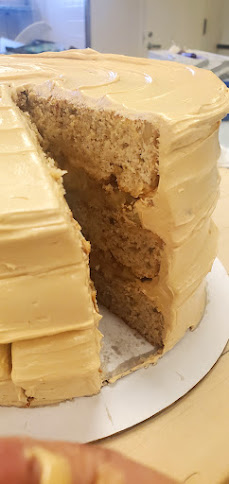Sourdough has a rep for being the no-nonsense, savory, earth-attuned kind of bake-craft. Doughnuts are the opposite of that -- fried, usually pretty sweet from being sugar-tossed or glazed and/or filled, with endless permutations of dress-up. There is the cronut, a hybrid of the flaky layers and oil-cooking, but even that has the frippery of lamination.
Given that I put starter in everything, is it any wonder that Sacchi would eventually find her way into doughnut dough? I consider this my last goodbye to a workplace that has seen me through some pretty cool, and some pretty rough, times, including many a doughnut station.
Why has it taken me this long to put up a post about these doughnuts I've been making for years? I really don't know.
Raised doughnuts are fried yeast dough; in theory, one can toss any kind of bread dough into boiling oil and out will come some semblance of satisfactory vehicle for glaze and filling. But good doughnuts are sweet dough, not too tough and lean like baguette dough, and not too high in fat, eggs or sugar that they disintegrate into the hot oil or sponge it up into soggy greasy sadness.
So what you need is a dough with enough structure to hold its shape as it rises, but soft enough so that the hot oil can cook the mass through in the time that it takes to brown the outside. Tender, flavorful but not too overwhelmingly bready, and with good handling so you can shape, rise and cook without panic.
(Cake doughnuts are another thing entirely. More thoughts on those another time, since of course. That other staple, fried choux/ French crullers, is again a different situation to talk about.)
Sure, you can fry brioche... but one doesn't need to go through the process of a sponge and careful gradual incorporation of butter if you're going to fry it, really. And brioche lacks the wherewithal to stand the manipulation that doughnuts must undergo. Best to leave brioche as little rolls or loaves that never see the fryer, and instead make a simpler dough which uses well-aged natural leavening to boost lightness and dexterity as well as flavor.
It's good to have all the ingredients on the cool side of room temp, as the mixing of the hook warms them up to the ideal fermenting zone.
Sourdoughnuts -- makes approximately 30, depending on size
225 g active starter
3 eggs
45 g sugar
7 g dry yeast, mixed with 15 g water
300 g bread flour
7 g sea salt
95 g butter, cubed
In the bowl of a stand mixer, combine the starter, eggs, sugar and dissolved yeast. Mix with a hook until the yolks are evenly dispersed.
Add the flour and salt and mix for 6 minutes on low speed. Look for the dough to be dry at first, then get sticky as the flour hydrates.
Add the butter cubes and mix another 2 minutes, then 5 minutes on medium speed. The dough should be smooth and elastic, and stick to itself more than the bowl. If it doesn't, add a bit more flour and mix until it does.
Turn the dough into a greased square or rectangular container that can contain double its volume. Cover with plastic wrap and let rise in the fridge 30 minutes; it should be puffy and cold all the way through.
Pick up the top two corners of the dough and press them to the middle; turn the container around and repeat for the other two corners. Deflate the whole mass and fold it in half, still in the container. Cover, refrigerate again and let rise another 20-30 minutes, until it has doubled.
Turn the dough out onto a floured surface.
Roll about 1/2 inch (1.5 cm) thick to cut with doughnut cutters -- 2.5 inch (6 cm) diameter outside, 3/4 inch (2 cm) inside.
Alternatively, divide into 25-30 g pieces and round into seamless balls for filled doughnuts.
As they are cut/shaped, space the doughnuts with enough room to rise on a nonstick mat- or greased paper-lined pan.
They can either rise at room temperature (depending on the dough temperature, it should take 15 -20 minutes), or refrigerated up to two days. For longer storage, freeze immediately (up to 2 weeks) then let rise and defrost at room temp.
Heat 2-3 inches (5-7.5 cm) of oil to 350F (180C) in a wide deep pot. Once the doughnuts are light to the touch, carefully place them 3 or 4 at a time in the pot, turning immediately so the whole surface of each has contact with the oil. This helps to keep the doughnuts round by stopping the surface from drying and causing uneven rising. Push them under the surface of the oil occasionally to cook the insides and prevent a white ring around the middle.
As they turn golden, drain the doughnuts on paper towels and keep them warm in a turned-off oven as you fry the rest.
While they are warm, roll the doughnuts in cinnamon sugar or granulated sugar. To fill them, poke a hole in the worse-looking side with a 1/4 inch (6 mm) plain piping tip while they are warm and the insides are not yet set. Let them cool before filling with jam or pastry cream.
For icing or glazing, let the doughnuts cool completely.
Chocolate doughnut glaze:
300 g confectioner's sugar
50 g unsweetened cocoa
40 g milk
2.5 g salt
200 g semisweet or bittersweet chocolate, melted and warm
Stir all together until smooth. Add boiling water to get a coating texture; if too thin, let cool. Dip doughnuts after filling.


























































